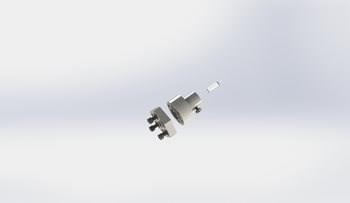The belief is that these inexpensive and compact sensors could offer an alternative to the magnetic resonance imaging (MRI) systems currently used to map brain activity without the expensive cooling or electromagnetic shielding required by MRI machines.
"A portable, low-cost brain imaging system that can operate at room temperature in unshielded environments would allow real-time brain activity mapping after potential concussions on the sports field and in conflict zones where the effect of explosives on the brain can be catastrophic," said researcher member Babak Amirsolaimani of the University of Arizona, Tucson.
According to the researchers, they were able to fabricate the magnetic sensors using optical fibres and a newly developed polymer-nanoparticle composite that is sensitive to magnetic fields. The sensors are able to detect the brain's magnetic field, the researchers claim, which is 100 million times weaker than the magnetic field of earth.
The team also showed that the sensor can detect the weak magnetic pattern of a human heartbeat and has the capability to detect magnetic fluctuations that change every microsecond from an area as small as 100 square microns.
"The all-optical design of the sensor means it could be fabricated inexpensively on a silicon photonics chip, making it possible to produce a system that is almost as small as the sensor's 10-micron-diameter optical fibre," said Amirsolaimani. "Multiple sensors could then be used together to provide high spatial resolution brain mapping."
The hope is the sensors could help scientists better understand the activity of the brain and diseases of the brain such as dementia and Alzheimer's. They might also be useful for measuring the magnetic fields used to predict volcanic eruptions and earthquakes, identify oil and minerals for excavation and detect military submarines.
| Below: The new sensors could offer an inexpensive and compact alternative to the magnetic resonance imaging (MRI) systems currently used to map brain activity. Shown here is a rendered image of one sensor. Credit: Babak Amirsolaimani, University of Arizona, Tucson |

Optical detection of magnetic fields
The optical method for detecting weak magnetic fields takes advantage of the fact that a magnetic field causes the polarisation of light to rotate, with the degree of rotation dependent on the material through which the light passes. The researchers developed a new composite material made of nanoparticles dispersed in a polymer that imparts a detectible polarisation rotation in light when very weak magnetic fields are present.
They selected nanoparticles based on magnetite and cobalt because these materials exhibit very high magnetic sensitivity. They then optimised the size, spacing and coating of the nanoparticles to create a composite material that is extremely sensitive to magnetic fields.
The researchers detected the polarisation rotation using an optical interferometer. This works by splitting laser light into two paths, one of which passes through the highly-sensitive material while the other does not. The polarisation of each light path is detected and compared to measure fluctuations in very small magnetic fields.
When detecting weak magnetic fields, noise can easily cover up the signal being detected. For this reason, the researchers used an interferometer setup that eliminates ambient environmental effects such as vibration and temperature fluctuations. This setup kept noise levels very close to the theoretical limit of the optical design, which was key for detecting very weak magnetic fields.
Using the sensors, the researchers measured the magnetic field created by electrical impulses produced during the human heartbeat. According to the team, they were able to detect a clear magnetic signal exhibiting high contrast, demonstrating the technology's potential as a simple replacement for electrocardiography, or ECG, tests commonly performed to detect heart problems.
Next, the researchers plan to study the long-term stability of the sensors and how well they withstand environmental changes. They also want to fabricate several hundred sensors to make a system for evaluating and imaging the entire magnetic field of a human brain.













